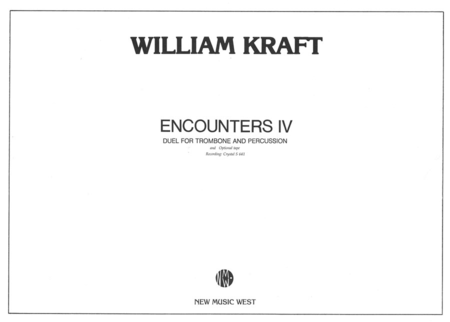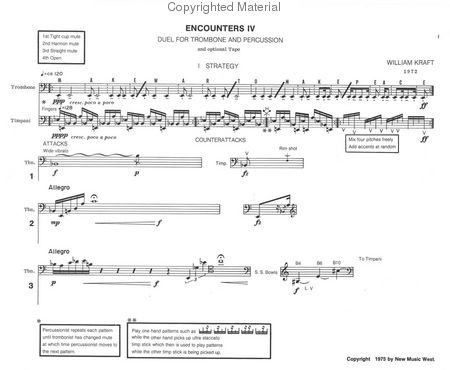Encounters IV
Duel for Trombone and Percussion (And Optional Tape)
-
Ships in 2 to 3 weeks
Details
Description
SKU: PR.114409760
Duel for Trombone and Percussion (And Optional Tape). Composed by William Kraft. New Music West. Classical. Set of performance scores. With Standard notation. Composed 1972. 16+16 pages. Duration 14 minutes, 30 seconds. Theodore Presser Company #114-40976. Published by Theodore Presser Company (PR.114409760).UPC: 680160014576. 14 x 11 inches.
Encounters IV was commissioned by Karen and Thomas Ervin for an album of duos which Ms. Ervin (now Karen Pershing) recorded for Crystal Records. Mr. Ervin was her trombone protagonist, not only on the recording, but also at the world premiere, which took place at the University of Arizona in March of 1973. Patterned after its predecessor, Encounters III: Duel for Trumpet and Percussion, Encounters IV is based on medieval warfare. The first movement, Strategy (the manner in which one engages the enemy) is made of series of attacks and counter-attacks, the trombone being the aggressor, the percussion responding from a fixed position - as did defenders in the middle ages. The opening has the trombone approaching and spelling out in Morse code an idea rather popular during the Second World War: Make war to make peace - while the defending percussionist strengthens his position with a growing ostinato. Then there are twelve attacks and counterattacks, which may be performed in different ways: 1) In order, one through twelve; 2) In an order predetermined by the performers; 3) In random order, in which the percussionist must immediately recognize the attack and respond accordingly. In this latter case, provisions must me made for those interlocked attacks and counterattacks which are simultaneous. The second movement is the most explicit commentary in the piece. It is titled Truce of God, after a medieval convention supervised by the Pope, wherein fighting was suspended from Thursday sundown to Monday sunrise. The ineffectuality of this convention against man's evidently stronger predilection for combat is represented by a variation which distorts the conductus Beata Viscera by the 13th century composer Perotin, accompanied by interspersed bell sounds of gongs, vibraphone and stainless steel bowls, along with various comments from the percussion. Added to this is a tape collage made up of World War I speeches, poems, and songs as well as similar material from later periods, created at the composer's direction by William Malloch from material Mr. Malloch had gathered and recorded. The third movement, Tactics (the way in which the battle is fought), is all-out-war, with the combatants locked in virtuosic battle climaxing in the defeat and retreat of the trombone, who spells out peace as he departs. --William Kraft.


 Share
Share